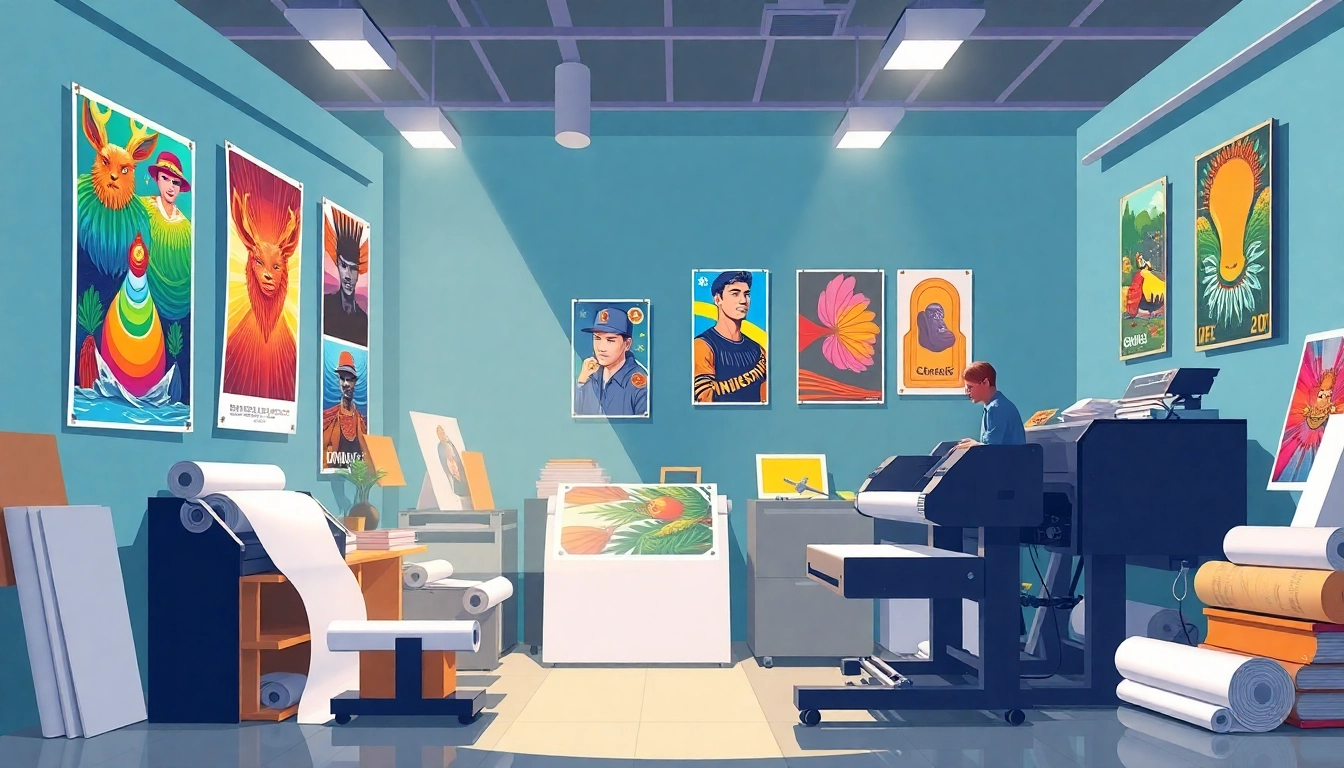Ultimate Guide to Poster Printing: 7 Strategies for Stunning Results

Understanding Poster Printing
What is Poster Printing?
Poster printing is a specialized form of printing designed to create large, visually appealing printed media that serves various purposes, from promotional materials to personal art displays. These printed artworks are typically made using high-quality inks and a variety of media such as paper, fabric, or vinyl. The appeal of poster printing lies in its ability to communicate a message or showcase art in a larger-than-life format, making it an effective tool for advertising, events, and personal expression.
The Evolution of Poster Printing Techniques
The history of poster printing goes back to the late 19th century, beginning with lithography techniques which enabled multiple colors to be transferred onto paper efficiently. As technology progressed, the introduction of offset printing and digital printing revolutionized the industry, allowing for even greater precision, speed, and versatility. Today, printing technologies such as inkjet and laser printing dominate the market, offering high-quality outputs and enabling custom designs that cater to individual preferences.
Types of Poster Printing Options
When considering poster printing, various options are available to suit different needs. These include:
- Standard Posters: Typically printed on high-quality paper, often used for advertising or decorative purposes.
- Vinyl Banners: Durable and weather-resistant, ideal for outdoor use.
- Fabric Posters: Lightweight and foldable, offering a unique texture and feel.
- Custom Shapes: Posters can be cut to any shape required, allowing for unique designs that stand out.
Key Factors in Poster Printing Quality
Choosing the Right Materials for Poster Printing
The choice of material is vital in the outcome of a printed poster. Common materials include:
- Paper: Available in various finishes such as glossy, matte, and satin, paper thickness can also impact durability and visual appeal.
- Vinyl: Perfect for outdoor posters due to resistance to moisture and fading.
- Fabric: Offers a rich texture and is often used for banners and custom displays.
Each material has unique benefits and is suited to specific applications, so it is essential to consider the intended use when selecting materials for poster printing.
Understanding Color Profiles in Poster Printing
Color fidelity is crucial in poster printing, making the understanding of color profiles essential. The two primary color models used in printing are RGB (Red, Green, Blue) and CMYK (Cyan, Magenta, Yellow, Black). While RGB is used primarily for digital displays, CMYK is tailored for printed media. Ensuring that designs are created within the CMYK color profile will help to avoid unexpected color discrepancies in the final print.
Importance of Resolution in Poster Printing
Resolution is another critical factor that affects print quality. For posters, a resolution of 300 DPI (dots per inch) is typically recommended to ensure a crisp and clear image. Lower resolutions can result in pixelation, undermining the professionalism of the print. When preparing images for printing, it is essential to designate all artwork at the appropriate size and resolution to maintain its integrity once printed.
Design Best Practices for Effective Poster Printing
Creating an Eye-Catching Layout
An effective poster design draws the viewer’s attention. Using a grid layout can help in organizing elements clearly while allowing for creative freedom. Key design principles such as balance, contrast, and hierarchy must be utilized to guide the viewer’s eye towards the most important messages. A clean and uncluttered design often leads to better outcomes.
Choosing Fonts and Text for Your Poster Printing
Typography plays a crucial role in the effectiveness of a poster. A limited number of font styles—ideally two to three complementary types—can create uniformity without overwhelming the viewer. Important text should be larger and bolder, while secondary information must be readable but not detractive from the main message.
Utilizing Images and Graphics in Poster Printing
Images and graphics can significantly enhance a poster’s aesthetic and communicative power. High-resolution images are crucial; they should be relevant and convey the intended message effortlessly. Custom illustrations can also be a good alternative to photographs, adding a unique touch that distinguishes your poster from others.
Common Challenges in Poster Printing and Solutions
Dealing with Color Discrepancies in Poster Printing
Color discrepancies often arise due to differences in screen display and printed output. To mitigate this, performing a test print or a proof before the final production is advisable. This helps in adjusting colors accurately and ensuring that the printed product meets expectations.
How to Avoid Blurry Text in Poster Printing
Blurry text can detract significantly from a poster’s professionalism. Ensuring that all text is vector-based PDF or ensuring images are at least 300 DPI can assist in maintaining clarity. Additionally, using legible fonts will enhance readability, especially at a distance.
Tips for Smooth Poster Printing Production
To avoid production issues, maintaining constant communication with the printing service is essential. Discussing options, obtaining proofs for approval, and being clear about deadlines can ensure the project goes smoothly. Additionally, proper file preparation, adhering to required specifications, and quality checks are key steps leading to a successful print run.
Evaluating Poster Printing Success Metrics
Measuring Engagement and Reach of Printed Posters
Once posters are distributed, it’s essential to evaluate their effectiveness. This can be done by tracking responses through promotions, asking viewers for feedback, or assessing how many people engage during events where the posters are displayed. The use of QR codes can facilitate direct interaction and measure engagement accurately.
Feedback Loop: Learning from Poster Printing Campaigns
Collecting feedback is vital for refining future poster designs and marketing strategies. Establishing a feedback loop allows for the analysis of what worked and what didn’t, enabling continuous improvement in both design and execution.
Scaling Your Poster Printing Efforts for Bigger Audiences
To reach broader audiences, consider scaling up production by leveraging digital marketing strategies alongside physical distribution. Collaborating with influencers or using social media to showcase your posters can enhance visibility and engagement, generating excitement around your message.






